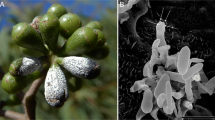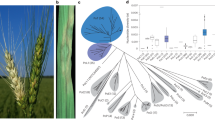Abstract
Pathogens are generally expected to evolve faster than their hosts and are therefore likely to be locally adapted. However, some pathogens might lag behind in the co-evolutionary arms race because they do not have some of the advantages shared by most other pathogens (e.g., high mutation or recombination rates, short generation time, high dispersal ability). This is the case of Microbotryum fungi that cause the anther smut disease in plants of the family Caryophyllaceae. We investigated the patterns of local adaptation and maladaptation in Microbotryum carthusianorum and its host plant Dianthus carthusianorum. We performed a full cross-inoculation experiment using half-sib plant families and fungal samples originating from three naturally infected populations in the Czech Republic. We specifically asked, which components of pathogen fitness (i.e., infectivity and host manipulation) are affected by local (mal)adaptation. The pathogen was on average 1.6 times more successful in infecting plants from foreign populations compared to plants from its home population. Once the infection was successful, the pathogen accelerated the plant’s flowering and thus increased the opportunity for transmission to new hosts. However, the level of manipulation of host flowering did not differ between home and foreign populations. This study showed that the pathogen’s infectivity followed a clear pattern of local maladaptation, whereas the host manipulation did not. Our study taken together with previous studies of a related anther smut species reveals the pervasiveness of local maladaptation in this group of pathogens that arises as the result of their restricted gene flow and reduced recombination rates.




Similar content being viewed by others
References
Alexander, H. M., & Antonovics, J. (1988). Disease spread and population dynamics of anther-smut infection of Silene alba caused by the fungus Ustilago violacea. The Journal of Ecology, 76(1), 91–104.
Alexander, H. M., & Antonovics, J. (1995). Spread of anther-smut disease (Ustilago violacea) and character correlations in a genetically variable experimental population of Silene alba. Journal of Ecology, 83(5), 783–794.
Alexander, H. M., Antonovics, J., & Kelly, A. W. (1993). Genotypic variation in plant disease resistance--physiological resistance in relation to field disease transmission. Journal of Ecology, 81(2), 325–333.
Baker, H. G. (1947). Infection of species of Melandrium by Ustilago violaceae (Pers.) Fuckel and the transmission of the resultant disease. Annals of Botany, 11(43), 333–348.
Bates, D., Maechler, M., Bolker, B., & Walker, S. (2015). Fitting linear mixed-effects models using {lme4}. Journal of Statistical Software, 67(1), 1–48.
Biere, A., & Antonovics, J. (1996). Sex-specific costs of resistance to the fungal pathogen Ustilago violacea (Microbotryum violaceum) in Silene alba. Evolution, 50(3), 1098–1110.
Biere, A., & Honders, S. C. (1996). Impact of flowering phenology of Silene alba and S . dioica on susceptibility to fungal infection and seed predation. Oikos, 77(3l), 467–480.
Biere, A., & Honders, S. C. (1998). Anther smut transmission in Silene latifolia and Silene dioica - impact of host traits, disease frequency and host density. International Journal of Plant Sciences, 159(2), 228–235.
Bloch, D., Werdenberg, N., & Erhardt, A. (2006). Pollination crisis in the butterfly-pollinated wild carnation Dianthus carthusianorum? New Phytologist, 169(4), 699–706.
Bolker, B. M., Brooks, M. E., Clark, C. J., Geange, S. W., Poulsen, J. R., Stevens, M. H. H., & White, J. S. S. (2009). Generalized linear mixed models: A practical guide for ecology and evolution. Trends in Ecology and Evolution, 24(3), 127–135.
Bruns, E., Hood, M. E., & Antonovics, J. (2015). Rate of resistance evolution and polymorphism in long- and short-lived hosts. Evolution, 69(2), 551–560.
Bruns, E., Antonovics, J., Carasso, V., & Hood, M. E. (2017). Transmission and temporal dynamics of anther-smut disease (Microbotryum) on alpine carnation (Dianthus pavonius). Journal of Ecology, 105, 1413–1424.
Bruns, E., Pierce, L., Antonovics, J., & Hood, M. E. (2020). Vector preference and heterogeneity in host sex ratio can affect pathogen spread in natural plant populations. Ecology, 102(3), e03246.
Buckling, A., & Rainey, P. B. (2002). Antagonistic coevolution between a bacterium and a bacteriophage. Proceedings of the Royal Society B: Biological Sciences, 269(1494), 931–936.
Buono, L., López-Villavicencio, M., Shykoff, J. A., Snirc, A., & Giraud, T. (2014). Influence of multiple infection and relatedness on virulence: Disease dynamics in an experimental plant population and its castrating parasite. PLoS One, 9(6), e98526.
Burdon, J. J. (1987). Diseases and plant population biology. Cambridge: Cambridge University Press.
R Core Team. (2012). R: A language and environment for statistical computing. Vienna: R Foundation for Statistical Computing.
Denchev, C. M., Giraud, T., & Hood, M. E. (2009). Three new species of anthericolous smut fungi on Caryophyllaceae. Mycologia Balcanica, 6, 79–84.
Ebert, D., & Hamilton, W. D. (1996). Sex against virulence: The coevolution of parasitic diseases. Trends in Ecology & Evolution, 11(2), 79–82.
Ericson, L., Burdon, J. J., & Müller, W. J. (2002). The rust pathogen Triphragmium ulmariae as a selective force affecting its host, Filipendula ulmaria. Journal of Ecology, 90(1), 167–178.
Feurtey, A., Gladieux, P., Hood, M. E., Snirc, A., Cornille, A., Rosenthal, L., & Giraud, T. (2016). Strong phylogeographic co-structure between the anther-smut fungus and its white campion host. New Phytologist, 212(3), 668–679.
Gandon, S., & Michalakis, Y. (2002). Local adaptation, evolutionary potential and host-parasite coevolution: Interactions between migration, mutation, population size and generation time. Journal of Evolutionary Biology, 15(3), 451–462.
Gandon, S., Capowiez, Y., Dubois, Y., Michalakis, Y., & Olivieri, I. (1996). Local adaptation and gene-for-gene coevolution in a metapopulation model. Proceedings of the Royal Society B: Biological Sciences, 263(1373), 1003–1009.
Gibson, W. (2015). Liaisons dangereuses: Sexual recombination among pathogenic trypanosomes. Research in Microbiology, 166(6), 459–466.
Giraud, T., Jonot, O., & Shykoff, J. A. (2005). Selfing propensity under choice conditions in a parasitic fungus, Microbotryum violaceum, and parameters influencing infection success in artificial inoculations. International Journal of Plant Sciences, 166(4), 649–657.
Greischar, M. A., & Koskella, B. (2007). A synthesis of experimental work on parasite local adaptation. Ecology Letters, 10(5), 418–434.
Hood, M. E., Antonovics, J., Wolf, M., Stern, Z. L., Giraud, T., & Abbate, J. L. (2019). Sympatry and interference of divergent Microbotryum pathogen species. Ecology and Evolution, 9(9), 5457–5467.
Jennersten, O. (1983). Butterfly visitors as vectors of Ustilago violacea spores between caryophyllaceous plants. Oikos, 40(1), 125–130.
Jennersten, O. (1988). Insect dispersal of fungal disease: Effects of Ustilago infection on pollinator attraction in Viscaria vulgaris. Oikos, 51(2), 163–170.
Kaltz, O., & Shykoff, J. A. (1998). Local adaptation in host–parasite systems. Heredity, 81(May), 361–370.
Kaltz, O., Gandon, S., Michalakis, Y., & Shykoff, J. A. (1999). Local maladaptation in the anther-smut fungus Microbotryum violaceum to its host plant Silene latifolia: Evidence from a cross-inoculation experiment. Evolution, 53(2), 395–407.
Kemler, M., Martín, M. P., Telleria, M. T., Schäfer, A. M., Yurkov, A., & Begerow, D. (2013). Contrasting phylogenetic patterns of anther smuts (Pucciniomycotina: Microbotryum) reflect phylogenetic patterns of their caryophyllaceous hosts. Organisms Diversity and Evolution, 13(2), 111–126.
Koupilová, K. (2017). Ekologie patosystému květní sněti u druhu Dianthus carthusianorum (ecology of the pathosystem of anther smut on Dianthus carthusianorum). Diploma thesis. Charles University.
Kovanda, M. (1990). Dianthus. In S. Hejný & B. Slavík (Eds.), Květena České republiky 2 (pp. 200–213). Praha: Academia.
Kuznetsova, A., Brockhoff, P. B., & Christensen, R. H. B. (2017). lmerTest package: Tests in linear mixed effects models. Journal of Statistical Software, 82(13), 1–26.
Le Gac, M., Hood, M. E., Fournier, E., & Giraud, T. (2007). Phylogenetic evidence of host-specific cryptic species in the anther smut fungus. Evolution, 61(1), 15–26.
Lion, S., & Gandon, S. (2015). Evolution of spatially structured host-parasite interactions. Journal of Evolutionary Biology, 28(1), 10–28.
Marr, D. L., & Delph, L. F. (2005). Spatial and temporal pattern of a pollinator-transmitted pathogen in a long-lived perennial, Silene acaulis. Evolutionary Ecology Research, 7, 335–352.
McArt, S. H., Koch, H., Irwin, R. E., & Adler, L. S. (2014). Arranging the bouquet of disease: Floral traits and the transmission of plant and animal pathogens. Ecology Letters, 17(5), 624–636.
Nakagawa, S., & Schielzeth, H. (2013). A general and simple method for obtaining R2 from generalized linear mixed-effects models. Methods in Ecology and Evolution, 4(2), 133–142.
Niemi, L., Wennström, A., Hjältén, J., Waldmann, P., & Ericson, L. (2006). Spatial variation in resistance and virulence in the host-pathogen system Salix triandra-Melampsora amygdalinae. Journal of Ecology, 94(5), 915–921.
Ochman, H., Lawrence, J. G., & Groisman, E. (2000). Lateral gene transfer and the nature of bacterial. Nature, 405, 299–304.
Oppliger, A., Vernet, R., & Baez, M. (1999). Parasite local maladaptation in the Canarian lizard Gallotia galloti (Reptilia: Lacertidae) parasitized by haemogregarian blood parasite. Journal of Evolutionary Biology, 12(5), 951–955.
Parker, M. A. (1989). Disease impact and local genetic diversity in the clonal plant Podophyllum peltatum. Evolution, 43(3), 540–547.
Petit, E., Silver, C., Cornille, A., Gladieux, P., Rosenthal, L., Bruns, E., Yee, S., Antonovics, J., Giraud, T., & Hood, M. E. (2017). Co-occurrence and hybridization of anther-smut pathogens specialized on Dianthus hosts. Molecular Ecology, 26(7), 1877–1890.
Refrégier, G., Le Gac, M., Jabbour, F., Widmer, A., Shykoff, J. A., Yockteng, R., Hood, M. E., & Giraud, T. (2008). Cophylogeny of the anther smut fungi and their caryophyllaceous hosts: Prevalence of host shifts and importance of delimiting parasite species for inferring cospeciation. BMC Evolutionary Biology, 8(100), 100.
Roche, B. M., Alexander, H. M., & Maltby, A. D. (1995). Dispersal and disease gradients of anther-smut infection of Silene Alba at different life stages. Ecology, 76(6), 1863–1871.
Roslin, T., Laine, A. L., & Gripenberg, S. (2007). Spatial population structure in an obligate plant pathogen colonizing oak Quercus robur. Functional Ecology, 21(6), 1168–1177.
Satterthwaite, F. E. (1946). An approximate distribution of estimates of variance components. Biometrics Bulletin, 2(6), 110–114.
Schäfer, A. M., Kemler, M., Bauer, R., & Begerow, D. (2010). The illustrated life cycle of Microbotryum on the host plant Silene latifolia. Botany, 88(10), 875–885.
Shykoff, J. A., & Kaltz, O. (1997). Effects of the anther smut fungus Microbotryum violaceum on host life history patterns in Silene latifolia (Caryophyllaceae). International Journal of Plant Sciences, 158(2), 164–171.
Shykoff, J. A., & Kaltz, O. (1998). Phenotypic changes in hosts plants diseased by Microbotryum violaceum: Parasite manipulation, side-effects, and trade-offs. International Journal of Plant Sciences, 159(2), 236–243.
Springer, Y. P. (2007). Clinal resistance structure and pathogen local adaptation in a serpentine flax-flax rust interaction. Evolution, 61(8), 1812–1822.
Thrall, P. H., & Jarosz, A. M. (1994). Host-pathogen dynamics in experimental populations of Silene alba and Ustilago violacea. I. Ecological and genetic determinants of disease spread. Journal of Ecology, 82(3), 549–559.
Thrall, P. H., Burdon, J. J., & Bever, J. D. (2002). Local adaptation in the Linum marginale-Melampsora lini host-pathogen interaction. Evolution, 56(7), 1340–1351.
Tinline, R. D., & MacNeill, B. H. (1969). Parasexuality in plant pathogenic fungi. Annual Review of Phytopathology, 7(1), 147–168.
Uchida, W., Matsunaga, S., Sugiyama, R., Kazama, Y., & Kawano, S. (2003). Morphological development of anthers induced by the dimorphic smut fungus Microbotryum violaceum in female flowers of the dioecious plant Silene latifolia. Planta, 218(2), 240–248.
Valente, L. M., Savolainen, V., & Vargas, P. (2010). Unparalleled rates of species diversification in Europe. Proceedings of the Royal Society B: Biological Sciences, 277(1687), 1489–1496.
Acknowledgements
We would like to thank Tomáš Herben, Patrik Mráz and anonymous reviewers for constructive comments on earlier drafts of the manuscript.
Author information
Authors and Affiliations
Corresponding author
Ethics declarations
Ethical approval
This article does not contain any studies with human participants or animals performed by any of the authors.
Conflict of interest
Authors declare that they have no conflict of interest.
Supplementary Information
ESM 1
(PDF 76 kb)
Rights and permissions
About this article
Cite this article
Koupilová, K., Koubek, T., Cornille, A. et al. Local maladaptation of the anther-smut fungus parasitizing Dianthus carthusianorum. Eur J Plant Pathol 160, 365–374 (2021). https://doi.org/10.1007/s10658-021-02249-0
Accepted:
Published:
Issue Date:
DOI: https://doi.org/10.1007/s10658-021-02249-0




